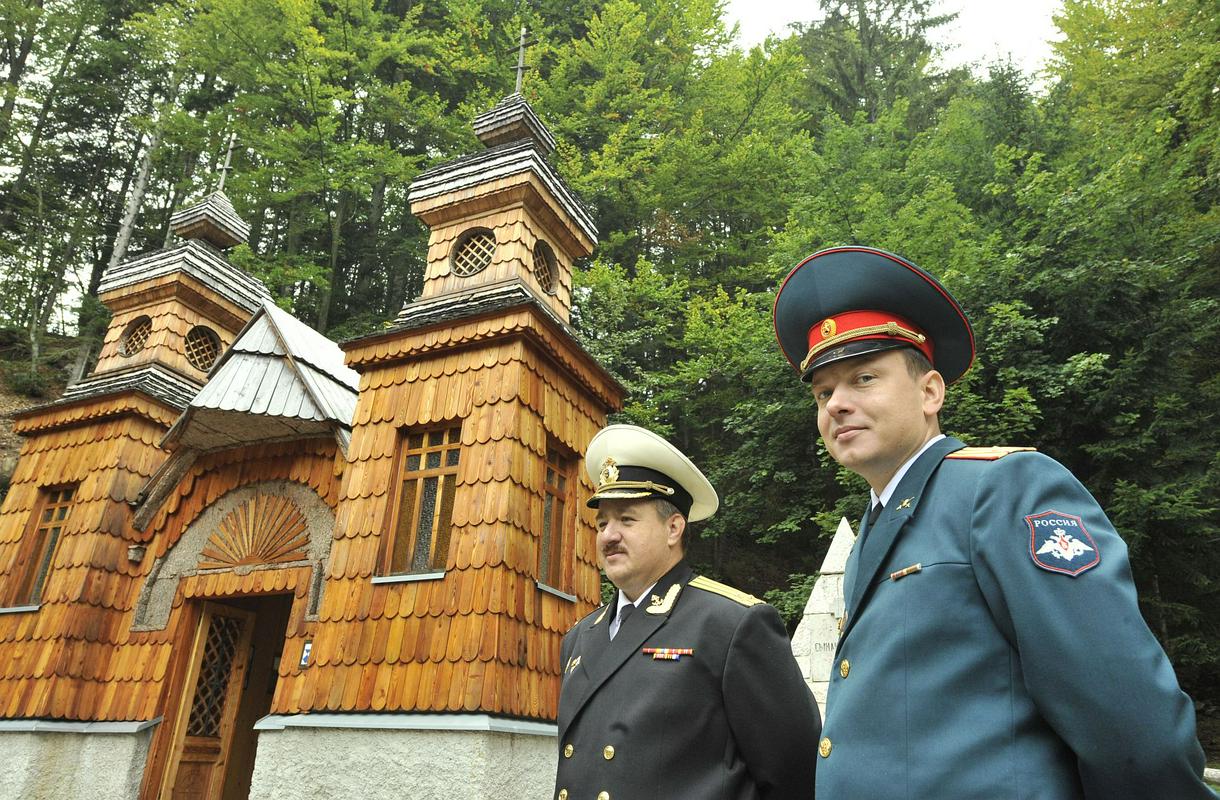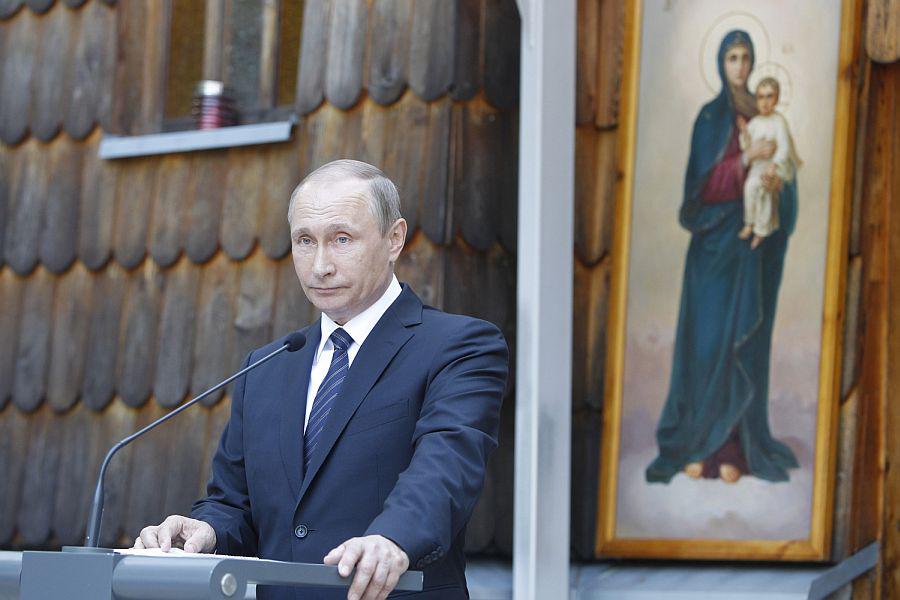

In the last hundred years, the Russian Chapel – the chapel of St. Vladimir on the Vršič pass, has played an important historic role, completing the mission to raise awareness of the atrocities and the senselessness of war. At the same time, it encourages passers-by to respect the life and invaluable dignity of every human being.



In 1992, when Slovenian and Russian Church delegations and state representatives met by the chapel for the first time, the Russian Chapel become a symbol of friendship between Slovenia and Russia. Every year, a celebration of St. Vladimir’s Day takes place on the last Sunday in July, which is a great opportunity to strengthen cultural, economic and other relations as well as develop powerful ecumenical bonds between the two Christian Churches.
In the last hundred years, the Russian Chapel – the chapel of St. Vladimir on the Vršič pass, has played an important historic role, completing the mission to raise awareness of the atrocities and the senselessness of war. At the same time, it encourages passers-by to respect the life and invaluable dignity of every human being.
The preservation of the Russian Chapel on the Vršič pass is a noble pursuit which enriches us and encourages the development of genuine relations, the prerequisite for mutual respect and peaceful co-existence.
Landmark events
Unfortunately, people have taken advantage of this genuine harmony too many times, simply because they yearned for more than they needed or were entitled to. In the past, at least two such events have put the kingdom of Triglav at the centre of attention.
The first known example dates back to Roman emperor Gaius Iulius Caesar (100 B.C. – 44 B.C.), who extended the tenth province (Venetia et Histria) so its borders reached the mountain peaks of the Black Sea/Adriatic watershed and thus also deep into the heart of the Triglav mountains. This action had a strong influence on the military outpost in the western part of the mountains, established in 50 B.C., i.e. the town of Forum Iulii bearing the name of Caeser, after whom the mountains in the hinterland of the then Forum Iulii – today’s Cividale del Friuli – were named: "Julian Alps".
The second occasion when Triglav mountain range was in the centre of the world's history was at the time of the Isonzo Front when tens of thousands of young soldiers from more than 22 nations fought, suffered, bled and died on World War I battlefields. During the World War I, ten thousand Russian war prisoners were sent to the Slovenian territory, coming from distant battlefields of Galicia. Some of them were ordered to the extremely challenging mountain road construction site of the road across the Vršič pass, which reaches the altitude of 1,611 metres and was built for military purposes, i.e. to supply the upper part of the Isonzo Front during the war. In Kranjska Gora, a large shanty town was built for Russian war prisoners and other soldiers who worked on the Vršič road, and numerous working barracks had also been built at specific points along the 30 km long mountain construction site so that the soldiers were stationed closer to work.
Two giant avalanches
Prisoners were often exhausted due to hard work and illnesses, and many work accidents and natural disasters occurred. One of the worst accidents recorded were the two avalanches from the Mojstrovka mountain that occurred on 8 and 12 March 1916 and killed 300 Russian war prisoners who were working on the Gorenjska side of the pass. In the same year, another avalanche was triggered, this time in the Trenta valley on the Bovec side of the pass, which claimed the lives of another 60 prisoners. On the basis of the military archival records, Kranjska Gora parish chronicles and other sources, historians estimate that during World War I, around one thousand Russian prisoners lost their lives on the Vršič road.
After the terrible avalanche disaster, a small Orthodox chapel made of wood and bark with two distinctive bulbous endings of the towers was built in a forest glade under the Vršič pass next to the medical shanties by the surviving Russian war prisoners, who wanted to honour the memory of their dead compatriots and give themselves spiritual support, whereas the bodies of the dead prisoners were buried in the nearby tomb. During the Vršič road enlargement works in 1937, constructor Josip Slavec from Kranj discovered skeletons, which were transferred, together with other remains of the Russian war prisoners, from the Kranjska Gora cemetery to the pyramid tombstone, which he built on the north-east side of the chapel of St. Vladimir.
With the help of the locals from Kranjska Gora, the surviving Russian war prisoners who stayed in Slovenia after the war was over and the Russians who joined them as refugees in 1921 have maintained and renovated the chapel throughout all these years.
In 2005, due to the weathering of bowls and especially the worn-out construction, the Ministry of Culture of the Republic of Slovenia started a reconstruction and restoration of the interior design so that the chapel was completely renovated for its 90th anniversary in 2006.
Paradise under Triglav
The Julian Alps of the Eastern Alps chain are really something special because of their geographical location and their white peaks of Trier and Jurassic limestones made from two hundred million years old Mesozoic marine sediments. A region with countless peaks, which reach from the mountain valleys up into the blue sky, studded with mountain lakes and clear waters; the north-eastern side is outlined by the Sava river with its river basin and its outflow into the Black Sea, and the south-western side with the Soča river and its outflow into the Adriatic Sea.
Today’s image of the "paradise under Triglav", as we like to call the area that covers 4,400 km2, was carved by the Triglav glacier at the end of the last ice age ten thousand years ago and in the next thousand years by man, who further contributed to the shape and appearance of this picturesque landscape with his presence and work.
Ancient myths and tales recount that the Triglav kingdom, named after the mighty mountain with the highest peak of 2864 meters, used to be ruled by white women, fairies and other mythical creatures who, with the help of Goldenhorn – a miracle goat with golden horns – jealously guarded the secrets of the kingdom from human greed and took especially vigilant care of marvellous treasures, carefully hidden in the Bogatin mountain.
In the last hundred years, the Russian Chapel – the chapel of St. Vladimir on the Vršič pass, has played an important historic role, completing the mission to raise awareness of the atrocities and the senselessness of war. At the same time, it encourages passers-by to respect the life and invaluable dignity of every human being.



























































